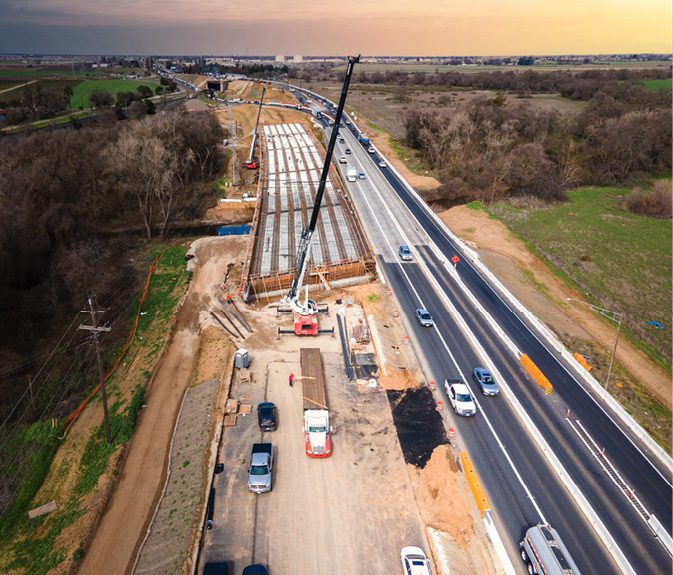Infrastructure Outlook: The Time to Embrace Digital Technology Is Now

These are unprecedented times for infrastructure development in the United States. With once-in-a-lifetime funding pumping $1.2 trillion into development through the Bipartisan Infrastructure Law (BIL), construction project volume is skyrocketing.
However, we’re all too aware that throwing money at a problem isn’t enough. In recent years, the United States has fallen from its place as a top-ranked country to its latest world ranking (by the World Economic Forum) of 13th for infrastructure quality. During this descent, we’ve spent more on roads than any other country that discloses expenditures.
According to Deloitte Consulting research, the lack of reliable data to make informed decisions about long-term asset maintenance has compounded operational inefficiencies, resulting in 5- to 8-percent increases in capital expenditures and 10- to 15-percent hikes in operating expenses.
Construction industry trends lead to further productivity reductions. While the rest of the U.S. economy has seen output double in the last 50 years, construction industry productivity has fallen in that same period by about 40 percent.
Advocating for ADCMS
Newly released BIL resources, however, create a viable path to address these issues and help regain our infrastructure leadership position. The Federal Highway Administration accepted applications for $34 million in combined FY2022 and FY2023 grant funding to support state DOTs in accelerating the use and deployment of Advanced Digital Construction Management Systems (ADCMSs). This includes digital technologies and business processes that modernize how government agencies, engineering and construction firms, and other private companies work together to deliver infrastructure projects more efficiently and cost-effectively.
Infrastructure owners can and should encourage the use of BIM and digital design workflows to take advantage of the 3D data created in that process. The data can be used in downstream processes to proactively address design issues before construction, saving money and time by eliminating the change requests that result from design errors. Working with BIM processes, 3D models and augmented reality also help reduce risks to worker safety by limiting the need for staff to be present on the construction site.
Beyond planning, ADCMS solutions integrate the tools that connect project data across all phases of the asset’s lifecycle—from design and construction to operation and maintenance. This holistic, collaborative approach leads to safer, greener, more-efficient projects that can save money and deliver equity and sustainability to taxpayers and their communities.

Digital technologies helped teams at Caltrans and Granite Construction collaborate efficiently to complete the Cosumnes River Bridge project a year ahead of schedule, minimizing traffic disruptions and environmental impacts while saving costs. (Granite Construction)
Early Adopters
In Minnesota, the Elk River redesign and reconstruction project connected three miles of Highway 169 to a new freeway system in Sherburne County. Smart use of advanced digital construction technologies on this project—Minnesota Department of Transportation’s first fully digitally designed-delivered construction project—resulted in an estimated $12 million in savings during the planning phase alone. The project team relocated 59 miles of utilities a full year ahead of schedule and began construction 12 months earlier than planned. Digital workflows used during construction helped further reduce the originally budgeted $158 million project, for an estimated total savings of $34 million.
The Cosumnes River Bridge Replacement project on State Route 99 in Sacramento County, Calif., provides yet another example of a state agency putting innovative technologies to use for taxpayers’ benefit. Teaming with Granite Construction, California Department of Transportation (Caltrans) used a connected data environment for the design model data, enabling efficient collaboration among the owner and contractor teams, who were able to review design information and optimize the design before breaking ground. Digital simulations prior to construction enabled the teams to shorten the construction schedule and reduce costs while increasing worker safety and minimizing environmental and traffic impacts. The project was completed a year ahead of schedule.
Digital technologies also offer powerful advantages for asset operations and maintenance. Using automated maintenance and reporting systems, the Idaho Transportation Department improved operations and reduced costs for winter snowplow operations. Real-time data analytics help maintenance crews keep Idaho roadways safe in severe weather, while cutting material use by 10 percent, resulting in more than $600,000 in annual savings. Process automations also lower operator input time by approximately 7,500 labor hours per year, which means team members can focus on higher-priority tasks that deliver more value to the agency and the public.
These are just three examples of state DOTs using digital technologies to make a significant difference. Widespread adoption of ADCMS solutions will generate new industry best practices and exponential marketplace benefits.
Time to Step Up
The federal government is demonstrating exceptional vision and creating practical solutions to drive needed change. The ADCMS funding promotes an asset-centric approach that maximizes interoperability and real-time sharing of the enormous amount of data and analysis required to manage, operate and maintain infrastructure assets more efficiently for years and decades to come.
We have before us a generational opportunity to improve the way our nation’s infrastructure is planned, designed, built, operated and maintained through the use of technology. Now, state DOTs—as well as local and regional officials throughout the country—must step up and embrace ADCMS deployment.
About Becky Tamashasky
Becky Tamashasky is sector vice president, product vision - asset lifecycle management, Trimble; email: [email protected].


